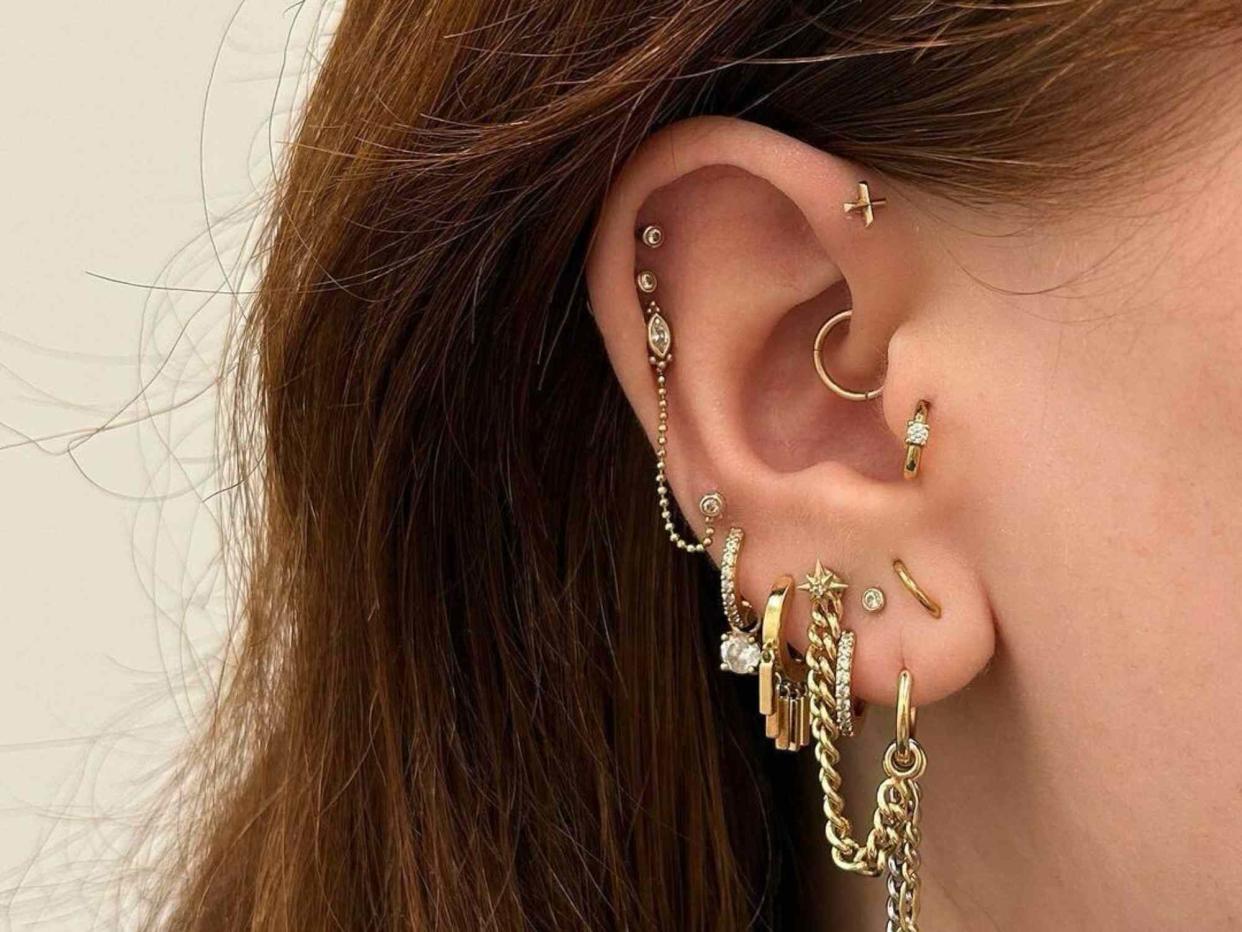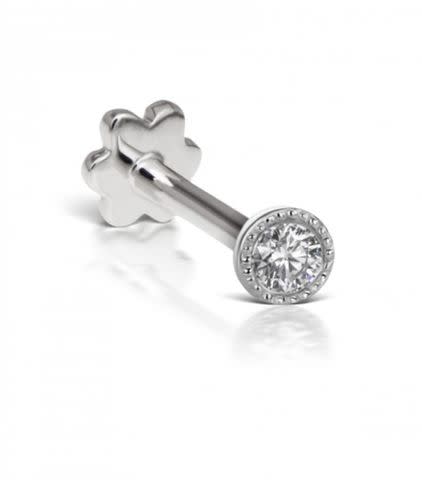A Complete Guide to Tragus Piercings

@studs / Instagram
Reviewed by Cozmo FarisFact checked by Anna Harris
If you're looking to alter your look in a way other than changing up your makeup, coloring your hair, or going for a cosmetic treatment, then opting for a body piercing may be the way to do it. For those who are a bit bolder and want to completely transform their face, an Ashley piercing or a snake bite piercing might be up your alley. However, if you're looking for a subtle yet stunning way to elevate your appearance then the tragus piercing could be just the one for you. Lots of celebrities from Rihanna to Zo? Kravitz and Chlo? Moretz have all been seen sporting a tragus piercing. And one of the best parts of this type of ear piercing is how customizable it is; you can opt for a more simple stud or more edgy earring for your tragus, according to your style.
To find everything you need to know about tragus piercings, we spoke to piercing experts, Jasmine Lewis and John Johnson, along with dermatologist, Howard Sobel, MD, to give us the lowdown. Keep scrolling to find out more about getting a tragus piercing, including the pain level, healing time, and cost.
Jasmine Lewis is the head piercer at Maria Tash and is an piercing expert.
John Johnson is a body piercing educator and is the owner of New Flower Studio Body Piercing, based in Long Beach, California.
Howard Sobel, MD, founder of Sobel Skin and attending dermatologist at Lenox Hill Hospital in New York
Tragus Piercing
Placement: The small piece of cartilage over the entrance to the ear canal
Pricing: $30-$40, plus the cost of the jewelry
Pain Level: 4/10
Healing Time: Six to 12 months
Aftercare: Clean twice a day with a sterile, saline-based solution. Avoid putting pressure on the area by not sleeping on the side with the earring until it heals.
What is a Tragus Piercing?
A tragus piercing sits on the small area of cartilage that partially covers your ear canal. In terms of anatomy, the outer ear is made up of cartilage and skin. While the fleshy lobe remains the preferred choice among traditionalists looking to get pierced, areas of cartilage, like the tragus, may entice those interested in something slightly different, or in addition to, their already pierced lobe. According to Lewis, "As piercers, we’re looking for a small flat area that will support being pierced. Provided your ear is suitable, [tragus piercings] look great on pretty much everyone."
You may have also heard of a surface tragus piercing, which is placed in the same area as the tragus piercing, except rather than puncturing the cartilage, just the skin is pierced. However, because the jewelry lies beneath the skin, there may be a higher probability of the body rejecting it, deeming it a foreign object that needs to be pushed out.
The Different Ways To Pierce the Tragus
According to Johnson, a tragus piercing may be performed with forceps, receiving tubes, or with no instruments at all. Some piercers may pierce front to back, others back to front. Needles may be standard piercing needles, O needles, or modified. They may also be curved.
"Tragus piercings are more likely to heal with a straight piece of jewelry, often called a stud, with a flat disc backing that closely matches the size of the decorative end in the front," he explains. "It's important that the angle is horizontal to the ground and the placement is outside the fold that separates the tragus from the face."
Pain and Healing Time
Sure, pain is relative—to a point. Generally speaking, how much does a tragus piercing hurt? Lewis says, "Most cartilage piercings to me feel like pressure rather than pain. For example, I’ve had both a tragus and helix piercing done, and I wouldn’t say one was more painful than the other. Although, people are sensitive in different areas, so the amount of pain you would feel will vary depending on the person." No pain, no gain, right?
While any ear cartilage piercing is tricky to heal, the tragus, in particular, gets in the way when talking on the phone, listening to earphones/earbuds, or using a Bluetooth earpiece. Germs are likely to be on those ear devices and can stunt your piercing's healing time. It's advisable to avoid anything from coming into direct contact with your tragus for at least a few weeks after getting pierced. "A lot of things will factor into the healing time of a piercing, but generally, we would say anywhere between six to 12 months," says Lewis.
Cost of a Tragus Piercing
The price of a tragus piercing will depend on where you're getting it done, less for reasons that have to do with the act of piercing than for the piece of jewelry. The cost of tragus piercings typically falls within a range of $30 to $40. Lewis elaborates, "Most inner ear cartilage piercings are roughly the same price. Jewelry choices vary, the only limitation being: How many diamonds?"
Aftercare
When considering getting any type of piercing, proper aftercare is paramount. After all, you don't want the excitement of your new earring to be overshadowed by said earring contracting an infection. In order to avoid such a scenario, Lewis recommends, "cleaning your piercing twice a day with a sterile saline solution for the first two to three months. Avoid touching or moving the piercing—any excessive trauma or pressure will prolong the healing process. To put it simply, leave the piercing alone unless you’re cleaning it!"
Dr. Sobel says to avoid "soap, shampoo or any disinfectants for the first day." He also suggests applying polysporin to the area. "I would even consider not using earphones/earbuds for the first four to eight weeks after the piercing," he says.
Lewis adds, "Applying any pressure onto the piercing while it’s healing will prolong the healing process. We would recommend not sleeping on it for the first couple of months. Travel pillows can come in handy to prevent pressure."
Byrdie Tip
Since the tragus piercing might swell more than other ear piercings, a ring would be much more challenging to heal, as it may not accommodate room for swelling. Instead, opt for a bar as your initial ear jewelry.
Side Effects of Piercing
Infection and scarring: "Note that there is low blood supply to this area of the ear, which makes a tragus piercing at higher risk for infection or scarring," says Dr. Sobel. Getting the piercing done by a professional and practicing proper aftercare will lower the chances of these side effects. "If you have any irritation or redness, it’s important to discuss with your dermatologist to find out the best solution for your specific needs," Dr. Sobel adds.
Allergic reactions: It's possible to have "allergic reactions to the type of metal used for the earring," according to Dr. Sobel. Common sensitivities include nickel, copper, and lower-quality gold. If you're sensitive to any metals, discuss this with your piercer before committing to a piece of jewelry.
Hypertrophic scarring: While not quite a keloid, hypertrophic scarring is caused by excessive amounts of tissue forming over the pierced area. This type of scarring "is common among cartilage piercings," says Dr. Sobel.
Blisters: "If you have any irritation or see a blister/bump, it could be from hypertrophic scarring, or it could be an infection/abscess fluid trapped under or behind the piercing," notes Dr. Sobel. While not all bumps are serious, it's important to see a doctor if you notice anything more than minor irritation in the area.
How to Change Out a Tragus Piercing
Avoid removing the piercing until it's completely healed. Before changing your tragus piercing (or any piercing, for that matter) be sure to wash your hands thoroughly with soap and water, and to clean the area regularly to disinfect and "avoid getting any bacteria in the area," says Dr. Sobel. He recommends cleansing the piercing itself with saline or a product like NeilMed's Piercing Aftercare Wound Wash ($15).
The individual steps will depend on whether your earring is a stud, hoop, barbell, etc. When in doubt, most piercing salons will change out an earring for free.
What Type of Jewelry Is Used for Tragus Piercing?
Maria Tash Scalloped Set Diamond Threaded Stud ($205)

Stud: Small and simple, studs are a great option for tragus piercings, which tend to be tiny. A ball stud, which has smooth edges that are less likely to snag on hair and clothing, is ideal for a new piercing. Once it heals, you can get more adventurous with your studs.
Barbell: A barbell is an earring with balls on both ends and a bar in the center. Tragus barbells will be smaller than most. This is another great option for a brand-new piercing, as it's easy to put in and keep clean.
Hoops: Teeny tiny hoops are another option for the tragus, although we suggest waiting until your piercing has healed before you try hoops with any unique shapes or textures.
What Jewelry Material Is Used for Tragus Piercing?
Stainless Steel: This is a high-quality metal often used for piercings, however, it contains some nickel, which Dr. Sobel says is "a very common source of irritation and piercing infection, as many people are sensitive to nickel in even the smallest amounts."
Gold: While it may be tempting to go for a metal that is at a lower price point, it's worth noting that higher-quality metals will encourage healing and are ideal for those with sensitive skin, according to Dr. Sobel. Inexpensive jewelry often contains nickel, notes Dr. Sobel, who recommends 14-karat gold.
Platinum: A gold alternative also approved by Dr. Sobel, platinum does not contain nickel, but has a similar look to stainless steel.
Frequently Asked Questions
What do tragus piercings help with?
Some believe that ear cartilage piercings, including tragus or daith piercings, work like acupuncture to treat or prevent migraine headaches. The studies available focus on daith piercings and not tragus piercings—and are inconclusive.Although there could be a placebo effect, most experts don’t recommend cartilage piercings for effective migraine treatment.
Can you wear earbuds with a tragus piercing?
Yes, but not initially. You need to wait at least three months before wearing your earbuds or headphones as it could irritate your tragus piercing, slow down healing and possibly cause an infection. You can, however, wear over the ear headphones that don’t apply pressure to the piercing.
Can you sleep on your side with a tragus piercing?
You will want to avoid sleeping on the side with the tragus piercing while it is healing—so for at least three months. Side sleepers should also consider getting a special pillow that has a cut-out for your ear. One great option is this Pillow with a Hole ($40).
Up Next: The Complete Guide to Getting an Anti-Tragus Piercing
Read the original article on Byrdie.